Amid renewed tensions between India and Pakistan, revisiting shared histories can build bridges, says Canada-based Harleen Singh whose debut non-fiction ‘The Lost Heer’ highlights the silenced stories of women from colonial Punjab. From Dr Premdevi, likely Punjab’s first female doctor to Khadija Begum–the ‘first Punjabi lady MA’, the book—which sprang from Singh’s seven-year-old Instagram archive—seeks to challenge divisive, male-centric narratives. The author talks to Sharmila Ganesan Ram about his singing grandma and other unsung women whose lives and legacies cross bordersYour book ‘The Lost Heer’ is dedicated to ‘Bibi’. Tell us about her. Did she play a role in shaping your curiosity about history?The Lost Heer is dedicated to my nani, whom I lovingly called Bibi. She was born in Sheikhupura and raised in Lahore, cities that became part of Pakistan in 1947. That year, she became a refugee, forced to leave behind her home, her community and a world that after that would live on only in her memories. Her folk songs carried centuries of emotion, her recipes preserved rituals of daily life and her stories painted vivid pictures of places I had never seen but could almost touch through her words. When I told her I’d submitted the manuscript of ‘The Lost Heer’, she gifted me her mother’s prized phulkari. Sadly, Bibi passed away before the book was published. But her voice, her spirit, and her stories live on in every page.You began volunteering at the 1947 Partition Archive in Delhi when you returned to India from Canada in 2014. Was that the seed for ‘The Lost Heer’ Project, the Instagram page you launched in 2018?Yes. I was in India on a summer break. Searching for ways to reconnect with the history I’d grown up hearing in fragments, especially from Bibi, I volunteered for the 1947 Partition Archive. It was a turning point. I interviewed Partition survivors, many of them women, and was struck by how much remained unsaid in public narratives. Women lamented the loss of their local recipes, folk songs, dialects and all the intimate domestic things. Layered with silences, grief, resilience and a quiet dignity, their stories were starkly different from that of men, which were usually stories of rags to riches. This planted the seed for ‘The Lost Heer’ Project, which I launched on Instagram in 2018 to create a space to explore women’s histories from colonial Punjab. This eventually grew into the book.‘The Lost Heer’ evokes Punjab’s legendary lover. What does Heer symbolize in your book?Heer is much more than a romantic figure—she’s a symbol of defiance, choice, and emotional strength in Punjab’s oral and literary tradition. I wanted to reclaim her not just as a tragic lover, but as a woman who speaks, resists, and asserts agency. Like Heer, many women in colonial Punjab lived through upheaval—displacement, violence, cultural loss—but their voices were rarely recorded. They were often remembered only through the men around them. By invoking Heer, I wanted to show that these voices aren’t lost. To me, Heer represents a quintessential Punjaban, a chorus of women whose truths have long been buried under history’s noise.As a male author telling the stories of women in colonial Punjab, were there moments of doubt or hesitation?Absolutely. I often questioned whether I could truly capture the nuances of their experiences, and whether I might unintentionally impose a modern or male gaze on histories that weren’t mine to claim. What guided me was a deep commitment to listening with care, humility, and respect. Much of ‘The Lost Heer’ is based on years of engaging with oral histories, family memories and the silences that run through the stories of Partition-era women. What struck me most was how often these women’s agency was overlooked–their choices, resilience, and emotional complexity reduced to stereotypes of suffering or sacrifice. These women were active participants in history, even when their options were painfully limited. The goal was never to speak for women but to hold space for their stories to speak through me.From teachers to preachers, poetesses to editors, your book uncovers the lives of many remarkable Heers including social reformer Dr Premdevi and writer Khadija Begum Ferozeuddin. Which stories moved or surprised you most?Hardevi Roshanlal’s story fascinated m. A child widow, she moved from Lahore to London in the 1880s, where she experienced ‘freedom’ from purdah for the first time. She learned the Montessori system, returned to Lahore in 1888 and set up a press and started Punjab’s first women’s magazine ‘Bharat Bhagini’. She didn’t stop there. Hardevi also wrote a Hindi travelogue called ‘Landan Yatra’, sharing her experiences abroad for Punjabi women to read. Later, she transformed into an anticolonial activist, organizing women’s gatherings within purdah and conspiring against the British during the intense disturbances in Punjab around 1907–1908. Her story revealed how women’s agency took many forms – education, publishing, political activism – amid social and political upheaval.Given the lack of documentation of women’s voices, how difficult was the research process?Many of these stories were hidden in silences, absent from official archives, or scattered across fragmented sources. To uncover them, I had to go beyond traditional histories and piece together clues from a wide range of materials: old newspapers, pension records, private letters, family papers, oral testimonies, etc. I call this process ‘informed imagination.’ It’s about carefully assembling these fragments, sometimes just names, dates, or brief mentions, and imagining the fuller lives behind them without straying from historical plausibility.You write that “controlling women’s sexuality” was a key concern in colonial Punjab…Controlling women’s sexuality in colonial Punjab was closely linked to the purdah system, which restricted women’s movement and enforced their seclusion as a marker of honour. Victorian morality clashed with local customs during this period, introducing new ideas of modesty. One major controversy was Punjabi women bathing naked in rivers—a long-standing communal practice seen as indecent by colonial officials and missionaries. This led to fines on men who failed to control their women and even debates at the 1893 Lahore Congress. Religious reform groups like Arya Samaj and Singh Sabha, influenced by Victorian values, pushed dress reforms, replacing traditional garments like the choli with fully covered attire like the kameez. While women’s bodies became battlegrounds for competing ideas, the women of Punjab continued to navigate, negotiate, and sometimes resist these norms in their own subtle ways. From purdah parties to early feminist journals, elite women engaged in various ways with both colonial power and local reform. What forms of agency stood out to you?What stood out to me was how they used the spaces available to them. Purdah parties, for instance, might seem like spaces of seclusion, but they were also sites of social networking, and collective organization. Women exchanged ideas, interacted with newer inventions, supported reformist causes, and sometimes even engaged in subtle resistance to colonial or patriarchal control: exposing a racist memsahib or decrying polygamy. Similarly, through editing and writing in early feminist journals, they challenged norms around education and women’s rights, engaging with both colonial and local reform movements on their own terms.How did caste, religion and class shape women’s experiences in colonial Punjab and how do these layered identities echo in South Asia today?Upper-caste women faced strict controls like purdah and arranged marriages but often had access to education and reform circles. Lower-caste women faced economic hardship and different social pressures, sometimes with more freedom from strict gender norms. Religious identities—Sikh, Hindu, Muslim—added further layers, all influenced by colonial laws regulating personal and social life. Today, these intersecting identities still affect women’s opportunities and challenges across South Asia, seen in ongoing debates around issues like triple talaq, polygamy, and women’s access to religious spaces.Recent works such as ‘The Kaurs of 1984’ have drawn attention to the voices of women in the aftermath of Operation Blue Star. In the context of today’s strained Indo-Pak and Indo-Canada ties, can historical storytelling–especially through the lens of unsung women–offer a bridge across borders in your view?Historical storytelling that focuses on unsung women can serve as bridges across strained borders by highlighting shared human experiences like loss and resilience. Women’s stories from Punjab—whether about Partition, Operation Blue Star, or migration—reveal connections that transcend political divides and challenge narrow nationalisms. These narratives remind us history is not just about nations, but about people, often women, whose lives and legacies cross borders in ways official politics rarely acknowledge. I believe storytelling grounded in empathy and complexity can foster healing and connection, helping us imagine futures where shared histories become foundations for peace rather than division.What’s next for ‘The Lost Heer’ Project? Do you envision these stories taking new forms—perhaps on stage, screen, or in classrooms?The archive is still growing. Thousands of stories remain undocumented, lying untouched and untranslated in archives, family collections, and oral histories. I hope these stories find new life on stage, screen, or in classrooms, reaching wider audiences and helping future generations connect deeply with their history and heritage.






